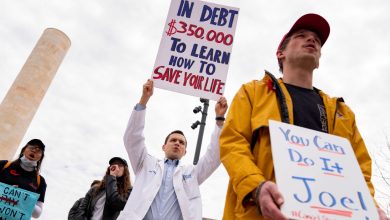Higher Ed’s Labor Force Is Nearly Back to Full Strength. Thank the Bureau of Labor Statistics.

[ad_1]
Higher ed had little to celebrate last November when the Bureau of Labor Statistics released its employment estimates for the sector. Academe had added basically zero jobs during the third-quarter of 2021, and the sector’s sputtering job recovery lagged more than six months behind the rebound that was then underway throughout the broader economy.
Fast forward to present day: Instead of a cumulative deficit of 300,000 higher-ed jobs lost since February 2020, that shortfall now sits at less than 40,000. And preliminary estimates suggest public colleges and universities have, strictly in terms of a top-line count, recovered the number of jobs lost over the course of the last two years, and then some.
The chief reason for the change? The bureau’s revised estimates suggest Covid-era job losses were not as extensive as previously reported. Instead of an all-time cumulative, seasonally adjusted low-point in December 2020 of over 610,000 jobs lost since the pandemic’s start, revised estimates peg the total fallout that month closer to 430,000 employees shed. To be sure, even with the revised totals, higher ed’s labor force still experienced historic job losses. America’s colleges and universities can’t point to another period since the 1960s when the sector shed so many employees so fast.
So what happened? The Bureau of Labor Statistics regularly makes revisions to its original and updated estimates of employment in order to capture the most accurate picture of work in America. Consider BLS’s estimate released earlier this month of the number of workers employed in February 2020 by state governments to provide education services. That data is preliminary. As BLS collects additional job data over the course of the next two months, the agency will in turn release updated estimates in April and May, respectively.
After collecting a year’s worth of monthly industry-level employment estimates, BLS will update the formulas used to calculate seasonal adjustments and revise, which means these numbers may come in for further adjustment.
Large revisions to recession-era industry-level employment estimates are nothing new. For example, between 2008 and 2013, the BLS’s estimate of employment within the retail sector during March 2008 would be revised upward by more than 100,000 jobs. Now, higher ed is witnessing a similar revision to estimates about its work force.
“The changes reflect improved seasonal adjustment models,” wrote Karen Kosanovich, a BLS economist, when The Chronicle inquired about the revisions to the higher-ed data. “Now that there are more monthly observations related to the historically large job losses and gains seen in the pandemic-driven recession and recovery, the models can better distinguish normal seasonal movements from underlying trends.”
[ad_2]
Source link






